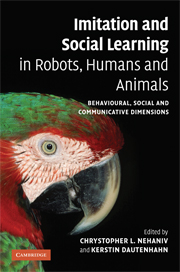 Imitation and Social Learning in Robots, Humans and Animals
Imitation and Social Learning in Robots, Humans and Animals Published online by Cambridge University Press: 10 December 2009
Imitation is an important form of learning, facilitating the acquisition of many skills without the time-consuming process of trial-and-error learning. Imitation is also associated with the ability to develop social skills and understand the goals, the intentions and the feelings of other people (Meltzoff and Prinz, 2002). The neural underpinnings of imitation and their possible evolutionary precursors have been recently investigated with different approaches, including neurological investigations, brain imaging, single cell recordings and computational models. This chapter discusses a neural architecture for imitation comprising superior temporal cortex, the rostral part of the posterior parietal cortex and inferior frontal cortex. The main thesis of the chapter is that the central role of imitation in the development of social skills is due to the functional properties of this neural architecture. These properties allow a common framework for third person knowledge (i.e. the observation of actions of others) and first person knowledge (i.e. internal motor plans).
Neurophysiology
Neurons in the superior temporal sulcus (STS) respond to moving biological stimuli, such as hands, faces and bodies (Jellema et al., 2002). The responses of some of these neurons occur only when the body or body part is engaged in goal-oriented actions, for instance when a hand reaches and grasps an object. The sight of a hand reaching toward the object but not grasping it will not activate these STS neurons. Point-light versions of the complete action, i.e. a hand reaching and grasping an object, however, do activate STS cells.
To save this book to your Kindle, first ensure [email protected] is added to your Approved Personal Document E-mail List under your Personal Document Settings on the Manage Your Content and Devices page of your Amazon account. Then enter the ‘name’ part of your Kindle email address below. Find out more about saving to your Kindle.
Note you can select to save to either the @free.kindle.com or @kindle.com variations. ‘@free.kindle.com’ emails are free but can only be saved to your device when it is connected to wi-fi. ‘@kindle.com’ emails can be delivered even when you are not connected to wi-fi, but note that service fees apply.
Find out more about the Kindle Personal Document Service.
To save content items to your account, please confirm that you agree to abide by our usage policies. If this is the first time you use this feature, you will be asked to authorise Cambridge Core to connect with your account. Find out more about saving content to Dropbox.
To save content items to your account, please confirm that you agree to abide by our usage policies. If this is the first time you use this feature, you will be asked to authorise Cambridge Core to connect with your account. Find out more about saving content to Google Drive.